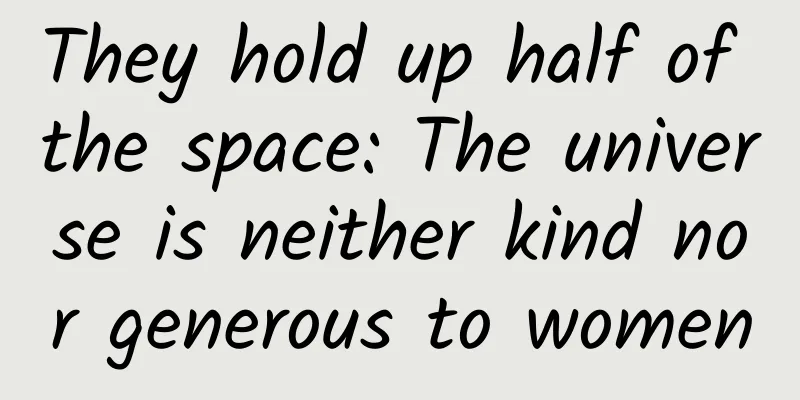They hold up half of the space: The universe is neither kind nor generous to women

|
So far, more than 60 women have been in space. What problems do female astronauts face in space? What improvements have researchers made for them? Why are there so few spacewalks by female astronauts? Written by reporter Wang Xueying, photo and text editor Chen Yongjie New Media Editor/Li Yunfeng Review expert: Pang Zhihao (Chief Scientific Communication Expert of National Space Exploration Technology) On October 16, three Chinese astronauts, Zhai Zhigang, Wang Yaping and Ye Guangfu, were ordered to carry out the Shenzhou 13 manned flight mission, and will stay in orbit for 6 months for the first time. Among them, Wang Yaping is the first Chinese female astronaut to enter the space station and the Chinese female astronaut who has stayed in space the longest. This mission will also make her the first Chinese female astronaut to leave the spacecraft. Female astronauts have always been a group that has attracted much attention from the outside world. People can't help but wonder: What are the differences in the selection of male and female astronauts? What difficulties do they have to overcome in space life? What are the advantages of women in space flight? Who says women are inferior to men? The stars and the sea are the most romantic ambition of mankind. In the 60 years of manned space flight, about 600 people have actually left the Earth's atmosphere. As of October 2021, 68 of them are women (including Chinese astronauts Liu Yang and Wang Yaping). Although the number of female astronauts is small, their achievements and sacrifices are no less than those of male astronauts. In 2021, the theme of World Space Week (October 4-10) is "Women in Space" - to commemorate those women who have made outstanding contributions to human exploration of space, and to inspire more women in the future to look up at the stars and forge ahead towards the stars. Two years after Gagarin completed the first human spaceflight, on June 16, 1963, the first female astronaut in human history, Valentina Tereshkova from the Soviet Union, entered space. During the nearly 71-hour flight, she flew 48 laps around the earth in the "Vostok 6" and completed biomedical and scientific exploration plans during the flight. In order to commemorate her pioneering work, a crater on the back of the moon was named after her. However, few people know that three years before Tereshkova's successful flight, NASA terminated the space training of 13 female astronauts on the grounds of "worrying about mission failure" and "affecting the training of male astronauts." ▲The female astronaut who made space history (Image by Chai Qingyan) On August 19, 1982, the Soviet Union sent its second female astronaut, Svetlana Savitskaya, into space. Two years later, during her last space flight, Savitskaya completed a spacewalk, becoming the world's first woman to walk in space. At the same time, Savitskaya, while serving as a flight engineer on the Soyuz T-12, tested new universal hand tools in space, cutting and welding metals, proving to the world that women can not only work and live on manned space stations, but can also perform various operations outside the cabin as required, just like male astronauts. More than a decade later, Russian female astronaut Yelena Kondakova also came to space, setting a world record for the length of time a woman had spent in space. On October 5, 2021, at 4:55 pm Beijing time, the Russian Soyuz MS-19 spacecraft was launched from the Baikonur Cosmodrome in Kazakhstan, sending 36-year-old beautiful actress Yulia Peresid to the International Space Station, along with director Klim Shipenko and astronaut Anton Shkaprov. This time, they stayed in the space station for 10 days to shoot a movie called "Challenge". ▲36-year-old Russian beautiful actress Yulia Peresid filmed the movie "Challenge" on the International Space Station (Photo source: Visual China) Despite missing out on many "firsts", the United States has more female astronauts in space than the Soviet Union: since the first female astronaut went into space on the Discovery in 1984, the total number of American female astronauts in space has been about 50. These women have proved one thing to the world: Who says women are inferior to men? Women can hold up half the sky! ▲On February 6, 2020, NASA astronaut Christina Koch returned to Earth after spending 328 days in space. This flight made her the female astronaut with the longest single space flight time at NASA. (Photo source: Visual China) Undiscriminatory selection and unique advantages "The universe is neither kind nor lenient to women, because we have to undergo the same brutal training as men." This is what Tereshkova said when she recalled her space training. Indeed, the harsh conditions in space will not change because of gender, so the selection and training of female astronauts will not be treated differently. As manned space activities have the characteristics of arduous tasks, complex skills, special environments, and great dangers, they are huge challenges to the astronauts both physically and mentally, requiring them to overcome a series of difficulties such as weightlessness, overweight, and lack of oxygen. ▲Chinese female astronaut Wang Yaping prepares for training in a centrifuge (Photo source: Visual China) However, it is undeniable that there are certain differences between men and women in terms of physiology and psychology. Female astronauts also have their own characteristics, such as more fat and less hemoglobin. Women's average height is lower than men, their average weight is lighter, and their ability to perform aerobic exercise is relatively low. These factors all lead to more difficulties for women to enter space flight, and they play the role of mission experts rather than flight experts when performing space missions. In addition, due to their different physiological structures, female astronauts need to bring sanitary products and use more water in space. Although the selection threshold is basically the same as that for men, for married female astronauts, because space flight sometimes encounters low pressure, considering that the increase in pressure on the human body can easily cause scars to open, only women who give birth naturally rather than by caesarean section can be selected, but pregnant women cannot participate in the selection. However, female astronauts also have their own unique advantages: Physiologically, women have lower blood pressure and peripheral vascular resistance than men, and a faster heart rate, which makes it easier for women to adapt to the environment. Previous studies have shown that female astronauts are better at recovering from gravity walking than male astronauts after returning to Earth. Similarly, women are more likely to recover from motion sickness than men. At the same time, in the weightless environment of space, women have better estrogen and magnesium metabolism, are less likely to have thrombosis, iron poisoning, vasospasm, arrhythmia and other problems, and are more suitable for long-term manned space flight. ▲NASA's introduction of female astronauts can actively adjust the atmosphere of the International Space Station and bring vitality to the crew (Image source: NASA) Psychologically, female astronauts have stronger endurance and confidence, are more adaptable to the space environment, have a stronger ability to endure loneliness, and have a more stable psychological quality. Compared with men, women are more sensitive and thoughtful, and are suitable for doing some delicate space science experiments that require great patience. They also perform better in jobs that require fine operating skills. Faced with a small and boring space journey, astronauts are prone to loneliness and anxiety, while female astronauts consider problems more comprehensively, pay more attention to ways and means of dealing with problems, have stronger language expression and communication skills, can actively adjust the atmosphere and bring vitality to the crew, improve the work efficiency of the entire team and reduce the error rate. ▲China's first female astronaut Liu Yang successfully exited the spacecraft (Photo source: Visual China) It can be said that the flight of female astronauts is of great benefit to all mankind. It will not only help to promote human medical research and improve our understanding of ourselves, but also promote the research of human space life sciences and help us better understand the universe and life. Space travel will not affect fertility Faced with the unknown universe, one of the questions people are most concerned about is: Without gravity, will female astronauts living in space still have menstruation? Practice has proved that female astronauts will have menstruation during space flight, and in microgravity, it will not cause "retrograde menstruation". For female astronauts all over the world, they can choose whether to have menstruation in space. Existing medical means can achieve the effect of amenorrhea by regulating hormones. For a long time, long-term continuous oral short-acting contraceptives have been a common choice for astronauts internationally. The advantages of this method are that it can be taken for a long time, it is well tolerated, and the risk of breakthrough bleeding is relatively low, but because this method requires daily medication, it is also a burden for busy female astronauts. In addition, the use of subcutaneous implants of simple progesterone or the placement of Mirena rings in the uterine cavity in advance can achieve the purpose of amenorrhea. ▲In April 2010, the International Space Station held its first "gathering" of four female astronauts (Photo source: Visual China) In addition to menstrual problems, the impact of the space environment on female ovarian function has also troubled many people - after a trip in space, can women still get pregnant and give birth normally? In this regard, the majority of female astronauts have given the answer with their own practice: After Tereshkova successfully returned to Earth in 1963, she married another astronaut and formed the first astronaut family in human history, and gave birth to a healthy baby girl the following year. In my country, Liu Yang, China's first female astronaut, returned to Earth in 2012 and became a mother in 2014. Wang Yaping also gave birth to her daughter successfully three years after returning... They have all proved to the world that human women who have experienced short-term space travel can get pregnant normally and give birth to healthy children. ▲Soviet astronaut Valentina Tereshkova and her daughter (Photo source: Russian Beyond) What about conception in space? In this regard, Russian female astronaut Kondakova, who has stayed in space for 169 days, believes that compared to whether conception can be successful in space, how to experience "ten months of pregnancy" under weightlessness is the most critical issue - even if babies can be born successfully in space, how can we bring them back to Earth safely? These puzzles are waiting for people to think about. Female astronauts can also be beautiful in space Russian experts once believed that there was "no need to dress up" in space, while the United States insisted that cosmetics such as perfume, lotion and lipstick were "essential". In September this year, my country's Tianzhou-3 cargo spacecraft also delivered cosmetics to female astronauts during its "express delivery" - 60 bottles of toner, 30 bottles of essence and 30 bottles of cream. Previously, Saarbrücken University in Germany conducted skin tests on three astronauts who returned from the International Space Station. They found that after a long space journey, the astronauts' dermis had more collagen, but the epidermis began to shrink, making the skin more susceptible to dangerous radioactive substances. On Earth, the thinning of the human epidermis is only related to human aging, but in the space environment, long-term exposure to the weightless, closed, and radiated environment of the space station will make the astronauts' skin barrier more vulnerable to damage, reduce skin moisture, become rougher, and lose elasticity. ▲In 1978, NASA customized a makeup kit for female astronauts, which included eyeliner, mascara, eye shadow, blush and other beauty products. (Photo source: Russian Beyond) In addition, long-term weightlessness will accelerate skin aging, and the confined space will make it easier for microorganisms to cross-infect, leading to more frequent skin allergies and itching. This also explains why some astronauts feel dry and itchy skin after living in space for a long time, and look older than their actual age. In response to this problem, my country has developed a "customized skin care kit" specifically for the Chinese space station's female astronauts. It uses -196 degrees ultra-low temperature to extract the nutrients from the flower embryos of Huangshan plum blossoms. The ingredients must be able to maintain high activity in the harsh space environment, mainly to solve skin aging problems such as dryness, collapse, and sagging. In addition to the ingredients, the packaging of these skin care products has also been adjusted to a convenient vacuum pump bottle design that is more suitable for use in the space station. Each time the pump head is pressed, the piston at the bottom of the bottle will move up, ensuring that the material is not contaminated by the external environment and ensuring the precise output of each pump, which can be said to be both convenient and clean. Now that we have the three-piece basic skincare set, what about makeup? Of course! It turns out that NASA has prepared toiletries for astronauts since the first time it sent people into space: when men were in power, the standard astronaut toiletries bag contained razors and shaving cream, lotion, dental floss, and lipstick. Interestingly, in order to ensure that everyone can use these things properly, astronauts need to do additional special training. With the addition of female astronauts, this toiletries bag has gradually added the function of beauty customization—even if you work in space, you have to look beautiful when taking photos! In this way, according to the beauty needs of different people, now, in the makeup bags prepared by NASA for female astronauts, eyeliner, mascara, eye shadow, blush, lip gloss...as long as they can pass the safety and flammability tests, they can have it! ▲Putting on makeup in space is no longer a dream (Image source: NASA) Although it is possible to put on makeup, in fact, most female astronauts are very busy in their daily work in space, and they have little time to put on a full and exquisite makeup. Kondakova also has a lot of experience in this regard: "Of course I can put on makeup on the orbital station, but there are so many things to do on the station that I hardly have time to put on makeup." As for dressing up like on Earth? "I only put on a little makeup on holidays," she said. Women's custom extravehicular space suit Unlike male astronauts, women are generally petite. In order to make female astronauts live more comfortably in space, scientific researchers have made improvements to the spacecraft from "Shenzhou 9" to "Shenzhou 13." In this regard, Pang Zhihao, chief scientific communication expert of national space exploration technology, said that one of the reasons why there are currently few space walks by female astronauts in the world is that there are no extravehicular space suits specifically suitable for women. ▲NASA astronauts Jessica Meir (left) and Christina Koch (right) prepare to leave the Quest airlock of the International Space Station to begin the historic first all-female spacewalk (Photo credit: NASA) "The most typical example is that the United States once wanted to conduct an all-female spacewalk - usually spacewalks are conducted by one man and one woman or two men, but at that time there was only one extravehicular spacesuit suitable for female astronauts on the space station," he said. "Later, a smaller extravehicular spacesuit suitable for female astronauts was transported to the space station, and only then was their first all-female spacewalk completed... This shows that extravehicular spacesuits are very important for spacewalks." In terms of space suits, in order to facilitate female astronauts to conduct experiments and operations in space, experts specially made molds based on the hand shapes of female astronauts and developed special gloves suitable for them to help them complete delicate tasks more flexibly. When walking outside the cabin, female astronauts, like male astronauts, have to wear a liquid cooling and ventilation underwear. This underwear is made of spandex elastic fiber, and there are about 100 meters of thin tubes running through the clothes, which continuously flow with coolant, which can dissipate heat from the astronauts' body surface. In order to facilitate the astronauts' movement, the joints of the clothes are also designed with bends. In addition, the sweat absorption function of this underwear is also very strong - it can absorb up to 2000 ml of sweat. The reason why this suit can absorb so much water is mainly because it is made of absorbent silica gel as the main material, which can absorb 400 times its own weight in water. The cabin of Shenzhou 13 also added a special cabin clothing spare parts package for female astronauts, and was equipped with a cabin pressure suit specifically for female astronauts, especially the female-specific extravehicular space suit sent by Tianzhou 3 this time. Its overall design is the same as the performance of other second-generation "Feitian" extravehicular space suits, but the total weight is lighter than before, and the size and dimensions are also tailored for Wang Yaping, so it is more fitting, more flexible when leaving the cabin, and can reduce physical exertion. Female astronauts are a key link in realizing humanity's dream of going into space. As more and more female astronauts enter space, it will also inspire more capable and qualified women to join the space industry. How do female astronauts deal with "inconvenience" in space? Since female astronauts will have their periods in space, what should they do if they have their periods in space? Space supplies are very precious, and astronauts often purify urine and recycle it into drinking water. However, there is currently no suitable purification method for blood during menstruation, and it cannot be directly recycled through the toilet's recycling system, otherwise it will pollute the purification system. Therefore, women's blood during menstruation must be stored separately. If the number of female astronauts increases in the future and the size of the spacecraft increases, perhaps they will distinguish between male and female toilets and use different purification systems. In terms of cabin design, the seats of the "Shenzhou 13" spacecraft are customized according to the body shape of female astronauts, and the urine and feces collection system is also adjusted for height and distance. ▲The toilet used by female astronauts in 1994 (Photo source: toilet-grun) In order to ensure that the menstrual period is passed normally, the space supplies must also take into account the exclusive items such as sanitary napkins and tampons for female astronauts. How many sanitary products are enough to take to space? For rockets with a carrying capacity that must be accurate to grams, this requires the precise determination of the number of sanitary napkins or tampons - this is determined by the female astronauts themselves. After the United States sent female astronauts into space, it prepared 100 sanitary napkins for them every month. Wang Yaping, the only female astronaut in the "Shenzhou 13" trio, will also receive women's clothing, sanitary products, chocolate, desserts, blood tonic products and other items. ▲Menstrual products on Earth are also effective in space (Image source: NASA) It is worth mentioning that women's menstruation can be affected by various external factors, such as excessive fatigue, excessive tension or excitement, long-term anxiety, etc., which may affect the time and blood volume of menstruation, and these problems are also faced by female astronauts "far away in the sky". Due to the reduction of blood volume in the whole body, female astronauts who are menstruating are very likely to suffer from decompression sickness if they conduct extravehicular activities. At this time, female astronauts are not suitable for spacewalks. (Source: Beijing Daily, China Aerospace News, National Space Administration, NASA official website) Produced by: Science Central Kitchen Produced by: Beijing Science and Technology News | Science Plus Client Welcome to share to your circle of friends |
>>: Why do wild geese fly in a line or a V-formation?
Recommend
A guide to traveling with your parents (happy version)! Proven and effective
During the upcoming Spring Festival holiday, many...
Kuaishou information flow advertising, you will understand after reading it
summary: To help you understand the relevant know...
Mining giant Rio Tinto plans to expand self-driving truck fleet to cut costs
Reuters reported in the early morning of the 18th...
For online operation and promotion, can the hit H5 that goes viral be replicated?
In the past two years, we have seen H5s produced ...
What is the spirit of scientists?
On Youth Day, I saw a trending search on the topi...
Is it possible that the picture of the Milky Way drawn by humans based on imagination is wrong? It's not all imagination
What does the Milky Way look like? From the pictu...
Live broadcast 7 kinds of account playing teaching + short video operation + Qianchuan investment + anchor training full set of tutorial data package
Live broadcast 7 kinds of account starting teachi...
@All COPD patients, don’t just lie down because of asthma
Common symptoms in people with COPD include Frequ...
Recommend 5 information flow advertising case libraries, take them for free!
It is really difficult to make information flow a...
iOS 13.5 developer beta released, unlocking with a mask will be more convenient
Apple released the iOS 13.5 developer beta versio...
4 key points for an excellent event planning!
When it comes to event planning , perhaps in many...
How to use ROI data to increase downloads and purchase conversions?
In the first half, traffic acquisition is used to...
Hongmeng OS, Android, IOS, which one is the future?
After reading the beginning of the story, I was q...
3 wrong breakfast combinations, how long have you been eating like this?
For office workers and those who have trouble get...
Wearing black underwear makes you more likely to get cancer? The truth behind "Don't buy black underwear" is revealed
Black is one of the most common colors in textile...









